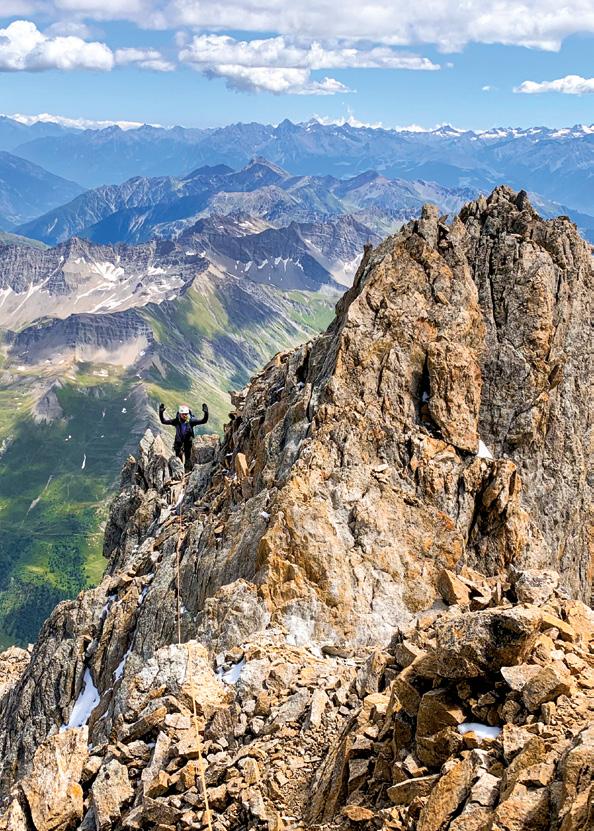
3 minute read
02. AIGUILLE DE CHATELET
composed of Max Boinniot, Pierre Labbre and M. Romain free climbed all its pitches. The route develops along a system of dihedrals and slabs with two decidedly harder pitches through enormous roofs: the third pitch of 7b and the seventh, 7a. In this guide you’ll find the grades as suggested by the French climbers.
P1 V+: follow the dihedral looking out for bad rock, 55 m, set up the anchor to the left. P2 6a: follow the dihedral moving onto the lefthand slab now and again until you come out of an overhang, then build your anchor in the crack at the end of the dihedral, 55 m, build your anchor. P3 7b: easy dihedral up to the roof, here you’ll find two pitons and some cracks in which to place some excellent friends. Difficult boulder move to come out of the roof, afterwards you’ll stay to the right until you reach a comfortable terrace, 45 m, build your anchor. P4 6b: beautiful little crack on a slab, aim for the roof above your head and go around it to the right, soon after you’ll find good terraces to anchor yourself, 40 m, build your anchor. P5 6c+: the best pitch of the route, amazing! Follow the dihedral with a crack until the end and with some acrobatics and balance get back on it 3 metres up. At this point, follow the dihedral past a terrace with an old piton and a small roof to reach the niche in which to set up the anchor, 40 m, build your anchor. P6 6a: easy pitch leading to the following roof, follow the evident cracks underneath the roofs all the way to a bolt, which is hard to see, under the following overhang, 20 m, anchor on two bolts. P7 7a: hard, physical boulder problem to top out of the roof protected with an excellent #0.3 friend, mantle onto the next slab, then you’ll encounter another move to protect using two excellent pitons: beware of the wobbly flake! Afterwards, continue left then set up the anchor on a small ledge, 35 m, build your anchor. P8 6b: slab leading to a roof that you’ll go around to the right, then delicate slab with a small crack all the way to the following terraces, 40 m, build your anchor. P9 V: begin to the right of the anchor and traverse, remain where the climbing is easy: careful, the rock towards the end is really bad, 50 m, build your anchor, though there’s also a piton. From here, follow the broken and unstable rocks paying a lot of attention not to move them too much. These 200 metres are easy but very unstable and there’s no obligatory route to go up. Aim for the ridge and follow it to the top.
8. Borat
M. Bonniot, S. Ratel - 2013 Length: 750m to the summit, the wall is 350m - 8 P Grade: 7b (6c obb.)/IV Exposure: South Gear: Double set of #0.3-#2 friends, a #3 and a double set of micros, a set of Offsets is also recommended.
Starting point: a beautiful dihedral of amazing rock is clearly visible about 60 metres above the ledge, the route begins directly below this, a little to the right of Groucho Marx.
The last route established on this beautiful wall, its authors are young and strong GMHM climbers! It was free climbed when established and follows dihedrals and cracks on the right-hand side of the wall, it’s extremely vertical and the rock quality seems superb. There’s no information about a first repetition of this route.
9. Cresta des Hirondelles
Just for information. Classical style ascent.
DESCENT For all the routes of the East Wall of the Grandes Jorasses, follow these indications: follow the beaten and evident normal route of the Grandes Jorasses. Pay attention to the time of descent due to snow bridges and rockfall.








